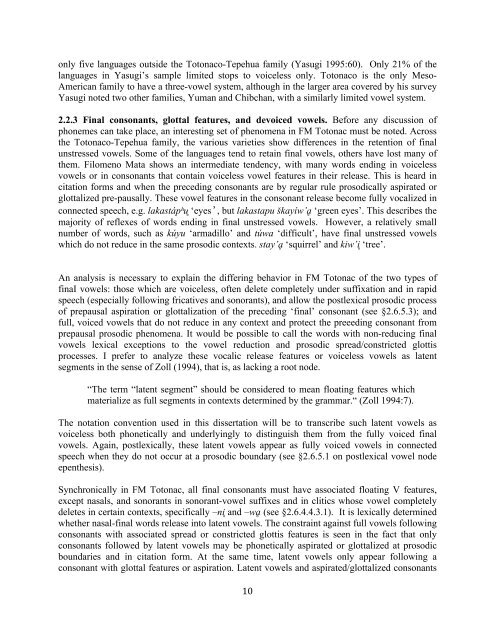The phonology and morphology of Filomeno Mata Totonac
The phonology and morphology of Filomeno Mata Totonac
The phonology and morphology of Filomeno Mata Totonac
You also want an ePaper? Increase the reach of your titles
YUMPU automatically turns print PDFs into web optimized ePapers that Google loves.
only five languages outside the <strong>Totonac</strong>o-Tepehua family (Yasugi 1995:60). Only 21% <strong>of</strong> the<br />
languages in Yasugi’s sample limited stops to voiceless only. <strong>Totonac</strong>o is the only Meso-<br />
American family to have a three-vowel system, although in the larger area covered by his survey<br />
Yasugi noted two other families, Yuman <strong>and</strong> Chibchan, with a similarly limited vowel system.<br />
2.2.3 Final consonants, glottal features, <strong>and</strong> devoiced vowels. Before any discussion <strong>of</strong><br />
phonemes can take place, an interesting set <strong>of</strong> phenomena in FM <strong>Totonac</strong> must be noted. Across<br />
the <strong>Totonac</strong>o-Tepehua family, the various varieties show differences in the retention <strong>of</strong> final<br />
unstressed vowels. Some <strong>of</strong> the languages tend to retain final vowels, others have lost many <strong>of</strong><br />
them. <strong>Filomeno</strong> <strong>Mata</strong> shows an intermediate tendency, with many words ending in voiceless<br />
vowels or in consonants that contain voiceless vowel features in their release. This is heard in<br />
citation forms <strong>and</strong> when the preceding consonants are by regular rule prosodically aspirated or<br />
glottalized pre-pausally. <strong>The</strong>se vowel features in the consonant release become fully vocalized in<br />
connected speech, e.g. lakastáp&u" ‘eyes!, but lakastapu #kayíw’! ‘green eyes’. This describes the<br />
majority <strong>of</strong> reflexes <strong>of</strong> words ending in final unstressed vowels. However, a relatively small<br />
number <strong>of</strong> words, such as kúyu ‘armadillo’ <strong>and</strong> túwa ‘difficult’, have final unstressed vowels<br />
which do not reduce in the same prosodic contexts. stay’! ‘squirrel’ <strong>and</strong> kiw’i" ‘tree’.<br />
An analysis is necessary to explain the differing behavior in FM <strong>Totonac</strong> <strong>of</strong> the two types <strong>of</strong><br />
finaI vowels: those which are voiceless, <strong>of</strong>ten delete completely under suffixation <strong>and</strong> in rapid<br />
speech (especially following fricatives <strong>and</strong> sonorants), <strong>and</strong> allow the postlexical prosodic process<br />
<strong>of</strong> prepausal aspiration or glottalization <strong>of</strong> the preceding ‘final’ consonant (see §2.6.5.3); <strong>and</strong><br />
full, voiced vowels that do not reduce in any context <strong>and</strong> protect the preeeding consonant from<br />
prepausal prosodic phenomena. It would be possible to call the words with non-reducing final<br />
vowels lexical exceptions to the vowel reduction <strong>and</strong> prosodic spread/constricted glottis<br />
processes. I prefer to analyze these vocalic release features or voiceless vowels as latent<br />
segments in the sense <strong>of</strong> Zoll (1994), that is, as lacking a root node.<br />
“<strong>The</strong> term “latent segment” should be considered to mean floating features which<br />
materialize as full segments in contexts determined by the grammar.“ (Zoll 1994:7).<br />
<strong>The</strong> notation convention used in this dissertation will be to transcribe such latent vowels as<br />
voiceless both phonetically <strong>and</strong> underlyingly to distinguish them from the fully voiced final<br />
vowels. Again, postlexically, these latent vowels appear as fully voiced vowels in connected<br />
speech when they do not occur at a prosodic boundary (see §2.6.5.1 on postlexical vowel node<br />
epenthesis).<br />
Synchronically in FM <strong>Totonac</strong>, all final consonants must have associated floating V features,<br />
except nasals, <strong>and</strong> sonorants in sonorant-vowel suffixes <strong>and</strong> in clitics whose vowel completely<br />
deletes in certain contexts, specifically –ni" <strong>and</strong> –w! (see §2.6.4.4.3.1). It is lexically determined<br />
whether nasal-final words release into latent vowels. <strong>The</strong> constraint against full vowels following<br />
consonants with associated spread or constricted glottis features is seen in the fact that only<br />
consonants followed by latent vowels may be phonetically aspirated or glottalized at prosodic<br />
boundaries <strong>and</strong> in citation form. At the same time, latent vowels only appear following a<br />
consonant with glottal features or aspiration. Latent vowels <strong>and</strong> aspirated/glottalized consonants<br />
! ".!

















